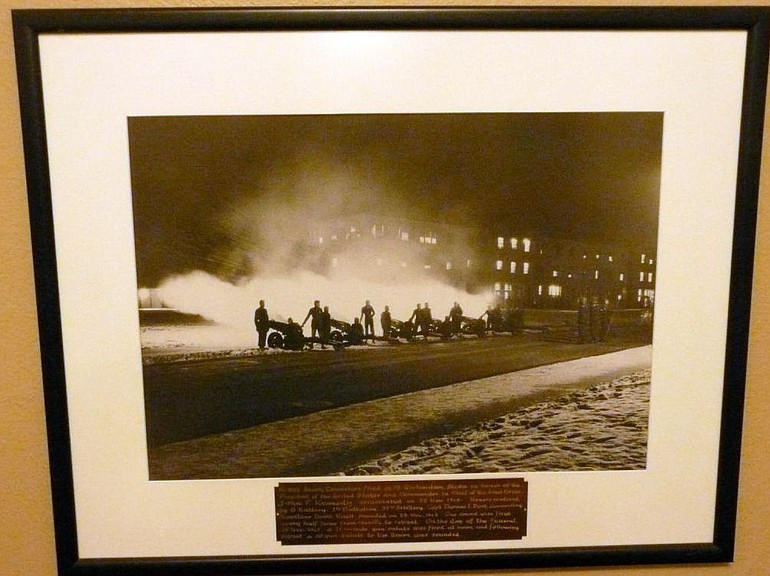Mrs. Verhoff, my fourth-grade teacher, was abruptly called into the hallway that day. She was visibly distraught upon re-entering the room and began to address the class. Through her tears we were informed the president of the United States, John Fitzgerald Kennedy, had been shot and killed.
It was Nov. 22, 1963. I was 9 years old.
At the beginning of the school year, Mrs. Verhoff had given each of us a small spiral notepad. Part of our daily ritual was to discuss current events and record observations, personal experiences and famous quotes into these little books. A lot of what we discussed was our young president. This man was a hero to us, and we would jot down his brilliant quotes in our daily journals to treasure and save as part of our history. How I wish I had that journal today.
Our family was living in Ft. Richardson, Alaska, about 15 miles from Anchorage. My father was an Army captain at the time and commanded a gun battery equipped with Pack 75mm howitzers (small cannons).
Nine-year-olds generally don’t know much about politics, so the attitudes of my parents became a starting point. We were visiting my grandfather’s house in Lewiston, Idaho, in 1960 during the first-ever televised presidential debate. The two men at the podiums seemed like background noise to me, but watching Dad’s excitement, love and respect for this young candidate, John Kennedy, got my attention. So Dad gave me the building blocks that inevitably led to me loving and admiring this president as much he did — and feeling the shock and loss just as much when Kennedy died.
Military honors are always extended to commanders-in-chief who have died. Cannon batteries fire death knells and 21-gun salutes as well as salutes to the Union. Some cannons leave behind a big brass shell casing when they have been fired. These casings are generally very badly burned from gunpowder and contain sulfur and other encrusted residue. Dad had the idea he was going to build a memorial tribute to the president by using important rounds from specific salutes of his fort’s cannons. He saved the casings and brought them home.
Family project
My sisters and I spent days cleaning these brass canisters to bring back their brilliant luster in preparation for lacquering. Not a particle of debris could be left on the shells. Getting down inside the casings was a job for small hands, and my sisters and I had those. We used every safe legal chemical known to man to get those rounds clean. There was a huge wash basin in the basement of our military quarters where we spent hours cleaning, scraping and polishing. All of us had raw hands from the days and days of scrubbing. It sounds like torture, but it was a family project and we all took turns seeing who could reach some of the more difficult areas and get the residue to budge.
Little by little the shell casings became shiny works of art. When dad felt they were worthy, off they went to a place unknown to my sisters and me.
When Dad’s memorial was unveiled, it made quite an impression and one of the local news stations in Anchorage did a piece on it. The backdrop was a large frame holding a black and white picture of dad’s cannon battery firing a night salute to President Kennedy. At the bottom center of the picture was a small brass plate inscribed with explanations of all the presidential gun salutes. Below that, in a smaller frame on pedestals, was a Life magazine photo of Black Jack, the famous horse that carried leather boots reversed in its stirrups — the symbol of a fallen leader — at the funeral. To the right and left of Black Jack were four special engraved howitzer rounds, saluting our fallen president.
The memorial slowly went to pieces over the years, due to too many moves and too many family problems. Some of it resides in my dad’s storage locker, some of it is in pieces at his residence. Years ago, he gave me the largest picture part. At the time there was no space, so I hung it on a side wall in my family room where it wasn’t seen much. As time has permitted, I’ve painted and cleared out areas of my home and now have the memorial prominently displayed in my hallway staircase, with good light to read the brass inscription plate.
This picture is something I will always treasure. It reminds me of the dad who used to be my hero and who taught me what a great leader John F. Kennedy was. There’s a song with the words “heroes don’t die,” and although my father and I are estranged now, Kennedy is still my hero. He taught me to believe in this country, to ask not what I could take but what I could give, to stand for what I believe in and to pick my battles wisely.
Everybody has a story welcomes nonfiction contributions, 1,000 words maximum, and relevant photographs. E-mail is the best way to send, so we don’t have to retype your words or borrow original photos. Send to: neighbors@columbian.com or P.O. Box 180, Vancouver WA 98666. Call Scott Hewitt, 360-735-4525, with questions.



